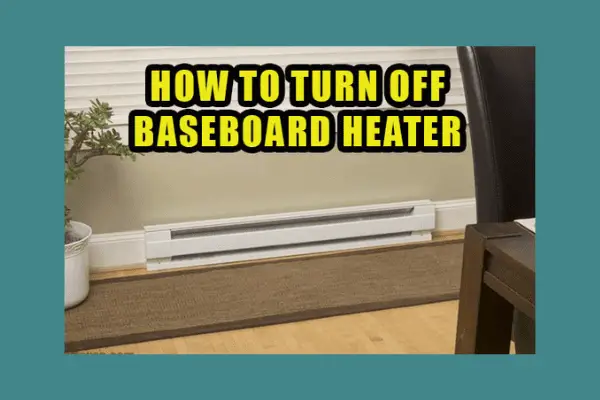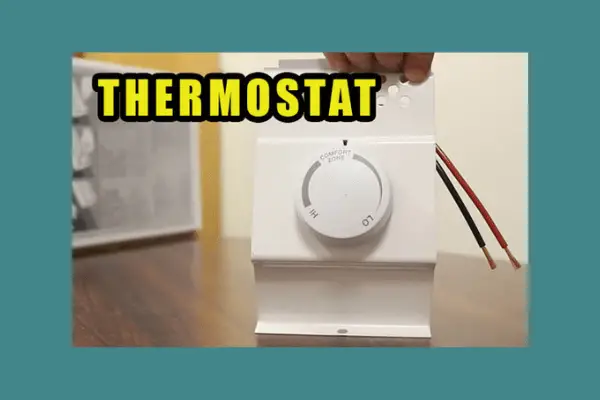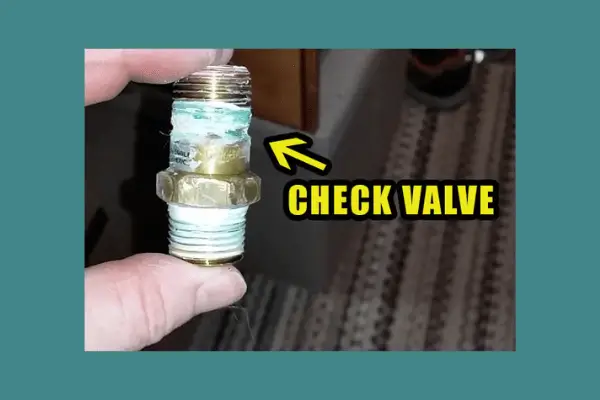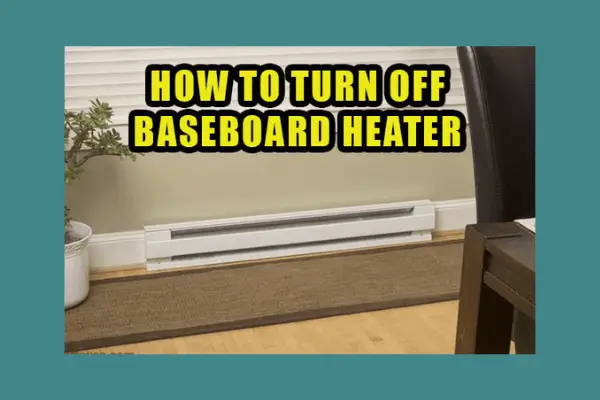There are many types of baseboard heaters that work differently from one another. You’ll learn how to turn off baseboard heater for all these types of baseboard heaters that are commonly available on the market.

We’ll also discuss the major issues that keep the heater from turning on and off and how you can fix each of these issues.
You’ll also learn some tips to block the heat coming from the heater so that you can have better control over the temperature in certain areas of your house. Let’s begin!
Table Of Contents
- How To Turn Off Baseboard Heater [5 Easy Methods]
- 1. How To Turn Off Baseboard Heater With Knob
- 2. How To Turn Off Baseboard Heater Without Knob
- 3. How To Turn Off Baseboard Heater With Thermostat
- 4. How To Turn Off Baseboard Heater Without the Thermostat
- How To Turn Off Baseboard Heater In One Room
- Why Baseboard Heater Won’t Turn Off
- i). Damaged Thermostat
- ii). Faulty Check Valve
- How To Block Heat Coming From Baseboard Heater
- Why Baseboard Heater Won’t Turn On
- 2. Blocking The Vents
- FAQs:
- How do turn on the baseboard heater with a knob?
- How do you measure the baseboard heater required for your room?
- How much does it cost to install a baseboard heater?
- How to check if your baseboard heater is working properly?
- What to do if the circuit breaker of a baseboard heater trips?
- Conclusion
How To Turn Off Baseboard Heater [5 Easy Methods]
It’s annoying when you turn off the baseboard heater and nothing happens. It’s easy to turn off the baseboard heaters when they come with a knob. But what if the knob doesn’t work correctly?
You can simply turn off the baseboard heater by adjusting the thermostat to the lowest settings.
If that doesn’t do the trick, this guide will teach you more about the different methods of turning off baseboard heaters. There are many baseboard heaters, each of which can be turned off with different techniques. The most common baseboard heaters are:
- Baseboard heaters with a knob.
- Baseboard heaters without a knob.
- Baseboard heaters with a thermostat.
- Baseboard heaters without a thermostat.
Note: You can also read how to fix Baseboard Heater not working in one room.
1. How To Turn Off Baseboard Heater With Knob
Baseboard heaters that come with a knob are the easiest to turn off. Some of them will have an “Off” position and others won’t. For those that have the off position marked in, just move the knob to that marking and that’ll turn off the heater.
For the ones that don’t have any “Off” position marked in them, adjust the knob to the lowest settings. As an extra step, you can also unplug the heater from the electrical outlet to ensure it stays off. Now you know how to turn off the electric baseboard heater with a knob easily.
Baseboard heaters with a knob are great to work with it because it’s not only easy to turn on and off but you can also adjust the temperature with ease.
Adjusting the knob to a higher position will make your room hotter and moving it to a lower position will make it colder.
2. How To Turn Off Baseboard Heater Without Knob
You may be thinking that it’ll be hard to turn off a baseboard heater that doesn’t have a knob but that’s not the case. We’ll use our trusty friend – the thermostat to turn off the heater that doesn’t have a knob.
You can simply adjust your thermostat to the lowest settings possible on your unit and that’ll turn off the heater.
There are many electrical baseboard heaters that have thermostats mounted on the wall to control the entire heater. You can easily turn them off using this method.
3. How To Turn Off Baseboard Heater With Thermostat
As already mentioned, you can easily turn off baseboard heaters that have a thermostat by dialing it to the lowest settings. Some baseboard heaters will have an off position and you can directly turn it off quickly by dialing the thermostat to that position.
If you’re wondering how to turn off the hot water baseboard heater, you can do it using the zone valve that is found near the boiler.
4. How To Turn Off Baseboard Heater Without the Thermostat
Most baseboard heaters come with a thermostat these days. But if you’re unlucky and your heater comes without a thermostat, you may be wondering how to turn off an electric baseboard heater without a thermostat.
In case your baseboard heater doesn’t have a thermostat, you need to locate the boiler or furnace switch for your heater. Once you locate that, you can easily turn the heater on and off using that switch.
How To Turn Off Baseboard Heater In One Room
If you have individual thermostats set up in each room, you can easily turn the heater on and off using that. But if you don’t have such a setup, you most probably won’t be able to turn off the heater in one room.
It’s difficult to turn off the baseboard heater in one room without a thermostat because the heating zones work as one big loop. You can’t just put a stop to it wherever you want.
You need to consider something serious like replumbing your house if you want to turn off the heater in individual rooms.
Each house comes with a different plumbing system and the challenges of replumbing them will also be unique. You need to hire a certified technician with a lot of experience for this job.
If you’re wondering how to turn off the water baseboard heater in one room, you can do it by adjusting the damper and reducing the heat transfer between them. If you have an electric baseboard, you can install a switch to control the temperature of the baseboard heater.
Why Baseboard Heater Won’t Turn Off
If there are certain issues with your baseboard heater, then it won’t turn off even if you follow the tips mentioned above. You should identify the root causes of this issue when it happens. Here are the main reasons behind it:
i). Damaged Thermostat
Nine times out of ten, it’s a faulty or broken thermostat that’s the main culprit behind your baseboard heater not turning off. There are some common indicators of a faulty thermostat that you need to be on the lookout for.
- AC running at all times can cause thermostat problems.
- The room temperature shown in the thermostat is different from the actual temperature.
- Low battery notification makes the thermostat malfunction.
- High electricity bill.
- It’s been a while since you’ve changed your thermostat and they’ve become worn out.
Apart from these common indicators of a bad thermostat, you can do a quick test to see if you actually have a faulty thermostat.

First, check if the thermostat is at the correct temperature that it shows. If it’s not the same, that means you have a faulty thermostat.
Secondly, reduce the temperature on your thermostat and see if it turns off the heater. If the temperature doesn’t increase and your baseboard heater still stays on, there’s a blockage connection in your thermostat.
Solution:
As a temporary fix to a permanent problem, you can clear the jammed contact by tapping on your thermostat. That’ll solve the problem for a while but you’ll have to eventually replace the thermostat to get your heater to work properly.
Follow these steps to replace the thermostat in your baseboard heater:
- Shut off the power to the thermostat so that no electricity can pass through it when you start working on it.
- Unscrew the screws that connect the cover plates to a wall using a screwdriver.
- Unscrew the mounting screws that keep the thermostat in its place.
- Take the thermostat out and keep it aside.
- Label the unexposed wires before you install the new thermostat so that you can remember which wire goes in which position.
- Remove the thermostat base attached to the wall after organizing the wires.
- Read the information in the manual to know every information you need to install the new thermostat.
- Install the new thermostat base and run a low-voltage wire through the base plate.
- Connect the wires to the new thermostat properly.
- Screw the thermostat on the wall with the mounting screws and make sure they’re connected tightly.
- Attach a cover as an extra step to protect your new thermostat from water shorting or other issues.
These were the general steps you should follow when installing a new thermostat for your baseboard heater. The installation process may be a little different depending on the model.
Once you’ve replaced the thermostat, check if it turns off properly. If it does, your problem is solved.
ii). Faulty Check Valve
A check valve is a tiny brass one-way port that’s integrated into hot water systems.

When the check valve becomes too old or gets damaged, it can keep the baseboard heater from turning off.
Solution:
If you have a faulty check valve, you need to replace it. A check valve can be easily replaced by following these steps:
- Turn off the water supply.
- Drain the water using the drain plug.
- Make sure that the hose attached to the check valve doesn’t have any water.
- Take the old check valve out by unscrewing it.
- Put the new check valve in its place.
- Attach the hose pipe.
Turn the water supply back on once you’ve installed the new check valve in place of the faulty one. If your heater turns off properly now, the check valve was causing the issue.
How To Block Heat Coming From Baseboard Heater
If you can’t turn off the heater even after trying and you want to control the temperature in specific rooms, there are certain ways in which you can block the heat coming from the heater to do so.
Here are some tips that’ll help you in blocking the heat coming from the baseboard heaters:
- Put a blanket and cover the radiator with it. That’ll significantly decrease the heat coming from it. Don’t do this if your baseboard heater is electric as it could start a fire.
- Rotate the rolling slot damper in your baseboard heater by hand to block the heat that’s coming from it.
- You can buy fireplace screens that you can place in front of your heater and that will also greatly reduce the heat coming from it.
Why Baseboard Heater Won’t Turn On
You know how to turn on the baseboard heater but what if it doesn’t work? There are many potential issues that can keep a baseboard heater from turning on. Here are the main reasons behind it:
1. Tripping Of The Circuit Breakers
A short circuit in the electrical system of your house can cause the circuit breaker to trip instantly when you turn on the baseboard heater.
Turn off the electricity and check your breaker box to see if that is the case. If the fuse is blown, that means the circuit breaker is tripped.
Another reason for the tripping of the circuit breakers is that you’re not using a fuse that has enough amperage. Baseboard heaters typically require fuses that have 20-30 amps and anything less than that can cause it to blow.
Solution:
The first thing you should do is replace the fuse and see if the heater works properly. The second thing is to check if you’re using the fuse of the correct amperage if it keeps blowing. Get a 20 amp or 30 amp fuse if the one you have is well below that.
If the fuse still keeps blowing, you can conclude that there’s a short. It can be caused by wiring issues like wrong wiring, exposed wires, or loose wire connections. It’s a good idea to have an electrician take a look at your electrical system and fix it when there’s a shortage.
2. Blocking The Vents
Things like curtain drapes, furniture, or other objects in your house can block the vents. That can not only keep the heater from turning on but they are also a fire hazard.
Solution:
Remove all the obstructions in front of the vents to make sure that your heater works properly. If you want to block the heat coming from it, use a fireplace screen instead.
3. Corroded Valves
If the valves aren’t lubricated properly, they can become corroded with time and prevent the heater from turning on. The build of dust and debris when you use the heater can also make it malfunction.
You’ll notice a burning smell coming from the heater when the dust has built up inside it and it’s being burnt.
Solution:
Cleaning and maintaining the heater properly will prevent issues like this one from occurring in the first place. If the valves are too badly corroded, you can replace them with new ones.
But try cleaning the valves and the vents first with a damp cloth while making sure that the heater stays cool. Wipe off the dust and call in a technician if the odor remains even after you clean it.
FAQs:
How do turn on the baseboard heater with a knob?
Adjust the knob in your baseboard heater to match your desired temperature and that’ll automatically turn it on and reach that temperature if your unit is plugged in and working fine.
How do you measure the baseboard heater required for your room?
A baseboard panel generally requires 10 watts of electricity per square foot. Calculate the total area of your room and multiply it by 10 to know how much is required for your room.
How much does it cost to install a baseboard heater?
The cost of installing a baseboard heater depends on the type of baseboard heater you’re going for. Electric baseboards generally range from $400 to $1200. The labor cost is $100- $200 per hour.
How to check if your baseboard heater is working properly?
If the circuit breaker, thermostat, and check valve of your heater work properly, you can be sure that your heater is working properly. But if there are any issues with any one of these components, your heater won’t function.
What to do if the circuit breaker of a baseboard heater trips?
Short-circuit is a common issue faced by many baseboard heater owners. You can replace the fuse when it happens. If that doesn’t work, you may need to replace the wires and update the circuit breaker.
Conclusion
Now you know how to turn off the baseboard heater and the different methods you can use to do it. Heaters with thermostats or knobs are much easier to work with and control compared to the ones that don’t have these parts.
Hopefully, you can also diagnose the common issues that keep your heater from both turning on and turning off after completing this article. Leave a comment below if you have any more questions about baseboard heaters.

